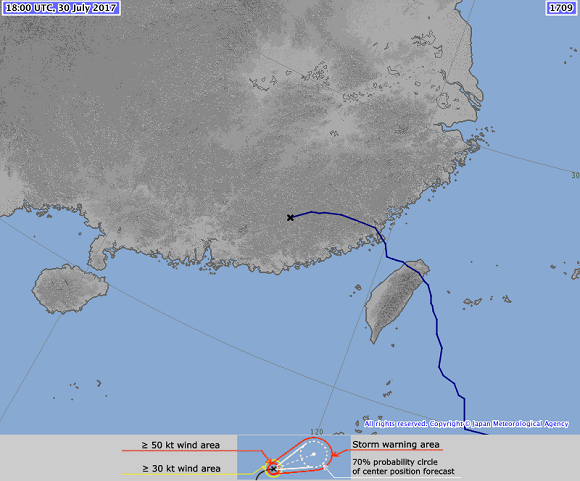Typhoon Nesat
Status: Closed
| Type of posting | Posting date(EST): | Summary | Downloads |
|---|---|---|---|
| Post Landfall 1 | 7/31/2017 9:00:00 AM |
|
|
| Landfall | 7/29/2017 12:00:00 PM |
|
Post Landfall 1 | Summary
Posting Date: July 31, 2017, 9:00:00 AM
After making landfall in Taiwan on Saturday, July 29, Typhoon Nesat continued northwestward across the South China Sea and made landfall in Fujian Province on Sunday morning (local time).
Meteorological Summary
The ninth typhoon of the year in the Pacific Basin, Nesat strengthened to typhoon status early Friday (UTC), July 28, and made its first landfall in Taiwan as a Category 2 equivalent storm. It then continued northwestward across the South China Sea toward southeastern China, where it made landfall in Fuqing City, Fujian Province, around 6:00 a.m. local time on Sunday, July 30 (22:00 UTC on Saturday, July 29) after traveling across Pingtan Island. At the time of landfall in China, maximum sustained winds were reported as approximately 119 km/h, and the minimum central pressure was ~980 mb.
Precipitation was exacerbated by the fact that Tropical Storm Haitan quickly followed Nesat’s landfall. The provincial flood control office said the combined impacts of Typhoon Nesat and Tropical Storm Haitang were expected to bring heavy rain and strong gales to Fujian Province, and precipitation totals could reach 500 mm in some areas. Mountainous regions could face high risks of geological disasters, such as landslides.
Reported Impacts
About 27,000 people had been evacuated to safety from fish farms in Fujian by Saturday prior to landfall. The local government in Fuqing City ordered officials and volunteers to step up patrols to ensure the safety of residents during the heavy rains. Local authorities also extended a fishing ban to August 1.
Reports of damage out of China for this event are extremely limited. Because this storm is mainly a precipitation event, damage is expected to be due to precipitation-induced flooding.
Exposure at Risk
Fujian is one of China’s more affluent provinces. Its capital, Fuzhou, is located on the coast and has a population of more than 7 million. Residences in urban areas are typically mid- or high-rise apartment buildings, many of which have commercial establishments on the ground floor. Mid-rise buildings are often confined masonry, while high-rises tend to be reinforced concrete or steel. China’s commercial and industrial building stock is diverse, and generally more resistant to wind and water damage than residential structures.
Historically, dominant construction types in China are unreinforced masonry made from adobe or brick, or brick with a light wood frame. These are still prevalent in more rural areas and are unlikely to be insured.
Forecast Track and Intensity
Typhoon Nesat tracked inland, moving west-southwestward after making landfall in southeastern China, and dissipated over mainland China late Sunday, July 30 (UTC).

Track map of Typhoon Nesat as of 18:00 UTC on July 30, 2017. (Source: JMA)